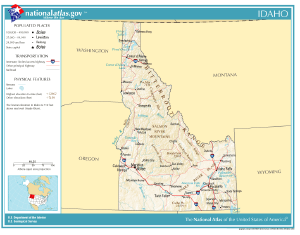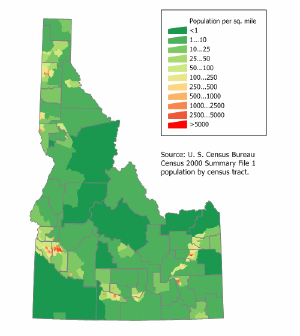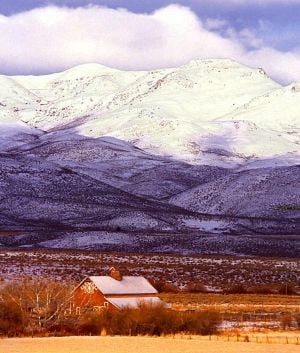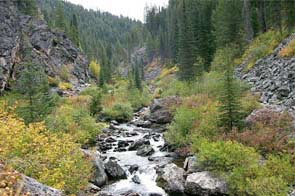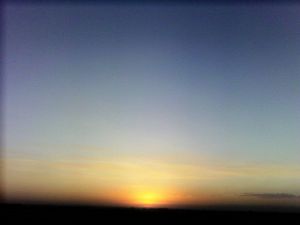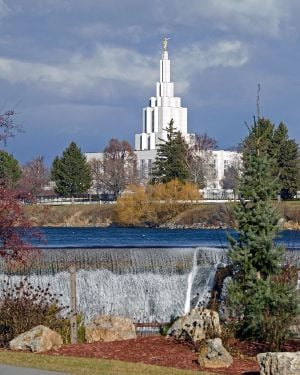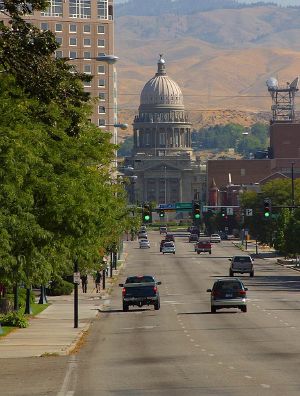Idaho
Template:US state
- For other uses, see Idaho (disambiguation).
The State of Idaho (IPA: /ˈaɪ.ɾəˌhoʊ/) is a state in the Pacific Northwest region of the United States of America. The state's largest city, and capital, is Boise. Residents are called "Idahoans." Idaho was admitted to the Union on July 3, 1890, as the 43rd state.
According to the United States Census Bureau, in 2004, Idaho had an estimated population of 1,393,262. The state's postal abbreviation is ID. Idaho is nicknamed the Gem State because of its abundance of natural resources. The state motto is Esto Perpetua (Latin for "Let it be perpetual").
Geography
Idaho borders the states of Washington, Oregon, Nevada, Utah, Montana, Wyoming and the Canadian province of British Columbia (the Idaho-BC border is 48 miles (77 km) long). The landscape is rugged with some of the largest unspoiled natural areas in the United States. It is a Rocky Mountain state with abundant natural resources and scenic areas. The state has snow-capped mountain ranges, rapids, placid lakes and steep canyons. The waters of Snake River rush through Hells Canyon, deeper than the Grand Canyon. Shoshone Falls plunges down rugged cliffs from a height greater than that of Niagara Falls.
The major rivers in Idaho are the Snake River, the Clearwater River and the Salmon River. Other significant rivers include the Boise River and the Payette River. The Port of Lewiston is the farthest inland seaport in the Pacific Northwest.
Idaho's highest point is Borah Peak, 12,662 ft (3,859 m), in the Lost River Range north of Mackay. Idaho's lowest point, 745 ft (227 m), is in Lewiston, where the Clearwater River joins the Snake River and continues into Washington.
Southern Idaho, including the Boise metropolitan area, Idaho Falls, Pocatello, and Twin Falls are in the Mountain Time Zone. Areas north of the Salmon River, including Coeur d'Alene, Moscow, and Lewiston, are in the Pacific Time Zone.
Climate
Idaho has much variation in its climate. Although the state's western border is located 300 miles (480 km) from the Pacific Ocean, the maritime influence is still felt in Idaho, especially in the winter when cloud cover, humidity, and precipitation are at their highest points. This influence has a moderating effect in the winter where temperatures are not as low as would otherwise be expected for a northern state with a mostly elevated altitude. The maritime influence is lowest in the southeastern part of the state where the precipitation patterns are often reversed, with wetter summers and drier winters, and seasonal temperature differences more extreme, showing a more continental climate.
Summers in Idaho can be hot, although extended periods over 100 °F for the maximum temperature are rare. Hot summer days are tempered by the low relative humidity and cooler evenings during summer months since, for most of the state, the highest diurnal difference in temperature is often in the summer. Winters can be cold, although extended periods of bitter cold weather below zero are unusual.
| Monthly Normal High and Low Temperatures For Various Idaho Cities. | ||||||||||||
| City | Jan | Feb | Mar | Apr | May | Jun | Jul | Aug | Sep | Oct | Nov | Dec |
|---|---|---|---|---|---|---|---|---|---|---|---|---|
| Boise | 37/24 | 44/29 | 54/34 | 62/39 | 71/47 | 80/54 | 89/60 | 88/60 | 77/51 | 64/41 | 48/32 | 37/24 |
| Lewiston | 39/28 | 46/31 | 54/36 | 62/41 | 70/47 | 78/54 | 88/59 | 88/59 | 77/51 | 62/41 | 47/34 | 39/28 |
| Pocatello | 32/16 | 39/21 | 48/27 | 58/33 | 68/39 | 78/46 | 88/51 | 87/50 | 76/42 | 62/33 | 44/25 | 34/17 |
| [1] | ||||||||||||
Lakes
- Lake Coeur d'Alene
- Priest Lake
- Payette Lake (McCall)
- Pend Oreille
- Lake Lowell
- Henry's Lake
- Stanley Lake
- Redfish Lake
- Alturas Lake
- Petit Lake
- Sawtooth Lake
- Warm Lake
- Bear Lake
- Lake Walcott
- Hayden Lake
- Lake Cascade
Adjacent States and Provinces
- British Columbia of Canada - north
- Montana - east by north
- Wyoming - east
- Utah - east by south
- Nevada - west by south
- Oregon - west
- Washington - north by west
History
Humans may have been present in the Idaho area as long as 14,500 years ago. Excavations at Wilson Butte Cave near Twin Falls in 1959 revealed evidence of human activity, including arrowheads, that rank among the oldest dated artifacts in North America. Native American tribes predominant in the area included the Nez Perce in the north and the Northern and Western Shoshone in the south.
Idaho, as part of the Oregon Country, was claimed by both the United States and United Kingdom until the United States gained undisputed jurisdiction in 1846. Between then and the creation of the Idaho Territory in 1863, parts of the present-day state were included in the Oregon, Washington, and Dakota Territories. The new territory included most of present-day Idaho, Montana, and Wyoming. The first organized communities, within the present borders of Idaho, were established in 1860.[2][3]
After some tribulation as a territory, including the chaotic transfer of the territorial capital from Lewiston to Boise, disenfranchisement of the large Mormon minority and a federal attempt to split the territory between Washington Territory and the state of Nevada, Idaho achieved statehood in 1890. The economy of the state, which had been primarily supported by metal mining, shifted towards agriculture and tourism.
In recent years, Idaho has expanded its commercial base as a tourism and agricultural state to include science and technology industries. Science and technology have become the largest single economic center (over 25% of the state's total revenue) within the state and are greater than agriculture, forestry and mining combined.[1]
The Idaho State Historical Society preserves and promotes Idaho’s cultural heritage.
Origin of name
Idaho is the only state that was likely named as the result of a hoax (the so called "Idahoax"). In the early 1860s, when the United States Congress was considering organizing a new territory in the Rocky Mountains, eccentric lobbyist George M. Willing suggested the name "Idaho," which he claimed was derived from a Shoshone language term meaning "the sun comes from the mountains" or "gem of the mountains." Willing later claimed that he had made up the name himself[4][5]. Congress ultimately decided to name the area Colorado Territory when it was created in February 1861.
However, the name "Idaho" did not go away. The same year Congress created Colorado Territory, a county called Idaho County was created in eastern Washington Territory. The county was named after a steamship named Idaho, which was launched on the Columbia River in 1860. It is unclear whether the steamship was named before or after Willing's claim was revealed. Regardless, a portion of Washington Territory, including Idaho County, was used to create Idaho Territory in 1863.
Despite this lack of evidence for the origin of the name, many textbooks well into the 20th century repeated as fact Willing's account that the name "Idaho" derived from the Shoshone term "ee-da-how."
- An excerpt from an Idaho History Textbook:
- "Idaho" is a Shoshoni Indian exclamation. The word consists of three parts. The first is "Ee," which in English conveys the idea of "coming down." The second is "dah" which is the Shoshoni stem or root for both "sun" and "mountain." The third syllable, "how," denotes the exclamation and stands for just the same thing in Indian that the exclamation mark (!) does in the English language. The Shoshoni word is "Ee-dah-how," and the Indian thought thus conveyed when translated into English means, "Behold! the sun coming down the mountain."
- "IDAHO in the Pacific Northwest." Barber -Martin. 1956. Caxton Printers Ltd. Library of Congress 55-5192.
Demographics
| Historical populations | |||
|---|---|---|---|
| Census | Pop. | %±
| |
| 1870 | 14,999 | ||
| 1880 | 32,610 | 117.4% | |
| 1890 | 88,548 | 171.5% | |
| 1900 | 161,772 | 82.7% | |
| 1910 | 325,594 | 101.3% | |
| 1920 | 431,866 | 32.6% | |
| 1930 | 445,032 | 3.0% | |
| 1940 | 524,873 | 17.9% | |
| 1950 | 588,637 | 12.1% | |
| 1960 | 667,191 | 13.3% | |
| 1970 | 712,567 | 6.8% | |
| 1980 | 943,935 | 32.5% | |
| 1990 | 1,006,749 | 6.7% | |
| 2000 | 1,293,953 | 28.5%
| |
As of 2005, Idaho has an estimated population of 1,429,096, which is an increase of 33,956, or 2.4%, from the prior year and an increase of 135,140, or 10.4%, since the year 2000. This includes a natural increase since the last census of 58,884 people (that is 111,131 births minus 52,247 deaths) and an increase due to net migration of 75,795 people into the state. Immigration from outside the United States resulted in a net increase of 14,522 people, and migration within the country produced a net increase of 61,273 people.
This makes Idaho the sixth fastest-growing state after Arizona, Nevada, Florida, Georgia, and Utah. From 2004 to 2005, Idaho grew the third-fastest, surpassed only by Nevada and Arizona.
Nampa, the state's second largest city, has experienced particularly strong growth in recent years. According to census estimates Nampa has grown 22.1% to nearly 65,000 residents between 2000 and 2003. Growth of 5% or more over the same period has also been observed in Caldwell, Coeur d'Alene, Meridian, Post Falls and Twin Falls [6].
Since 1990, Idaho's population has increased by 386,000 (38%).
The Boise Metropolitan Area (officially known as the Boise City-Nampa, ID Metropolitan Statistical Area) is Idaho's largest metropolitan area. Other metropolitan areas in order of size are Coeur d'Alene, Idaho Falls, Pocatello and Lewiston.
As of 2006, six official micropolitan statistical areas are based in Idaho. Twin Falls is the largest of these.
The center of population of Idaho is located in Custer County, in the town of Stanley [7].
| Demographics of Idaho (csv) | |||||
|---|---|---|---|---|---|
| By race | White | Black | AIAN | Asian | NHPI |
| AIAN is American Indian or Alaskan Native - NHPI is Native Hawaiian or Pacific Islander | |||||
| 2000 (total population) | 96.99% | 0.65% | 2.14% | 1.36% | 0.23% |
| 2000 (Hispanic only) | 7.53% | 0.10% | 0.28% | 0.07% | 0.03% |
| 2005 (total population) | 96.81% | 0.84% | 2.05% | 1.48% | 0.22% |
| 2005 (Hispanic only) | 8.70% | 0.17% | 0.27% | 0.08% | 0.03% |
| Growth 2000-2005 (total population) | 10.24% | 42.33% | 5.93% | 20.25% | 6.65% |
| Growth 2000-2005 (non-Hispanic only) | 8.78% | 33.87% | 5.74% | 19.96% | 7.09% |
| Growth 2000-2005 (Hispanic only) | 27.65% | 89.80% | 7.17% | 25.37% | 3.90% |
The largest reported ancestries in the state are: German (18.9%), English (18.1%), Irish (10%), American (8.4%), Norwegian (3.6%), Swedish (3.5%).
Religion
In 2004, the religious affiliations of Idahoans were surveyed as: [8]
- Protestant – 29.3%
- LDS (Mormon) – 22.8%
- Catholic – 14.3%
- Christian – 13.6%
- None – 12.7%
- Other – 7.2%
In 2001, the religious affiliations of the people of Idaho were surveyed as: [9] [10]
- Christian – 79%
- Other Religions – <1%
- Non-Religious – 20%
As with many other Western states, the percentage of Idaho's population identifying themselves as "non-religious" is higher than the national average.
Economy
Gross state product for 2004 was US$43.6 billion. The per capita income for 2004 was US$26,881. Idaho is an important agricultural state, producing nearly one third of the potatoes grown in the United States.
Important industries in Idaho are food processing, lumber and wood products, machinery, chemical products, paper products, electronics manufacturing, silver and other mining, and tourism. The world's largest factory for barrel cheese, the raw product for processed cheese is located in Gooding, Idaho. It has a capacity of 120,000 metric tons per year of barrel cheese and belongs to the Glanbia group.[3] The Idaho National Laboratory (INL), a government lab for nuclear energy research, is also an important part of the eastern Idaho economy. Idaho also is home to three facilities of Anheuser-Busch which provide a large part of the malt for breweries located across the nation.
Today, the largest industry in Idaho is the science and technology sector. It amounts for over 25% of the State's total revenue and 70%+ of the State's exports (in dollars). Idaho's industrial economy is growing, with high-tech products leading the way. Since the late 1970s, Boise has emerged as a center for semiconductor manufacturing. Boise is the home of Micron Technology Inc., the only U.S. manufacturer of dynamic random access memory (DRAM) chips. Hewlett-Packard has operated a large plant in Boise, in southwestern Idaho, since the 1970s, which is devoted primarily to Laserjet printers production.[11]. Dell, Inc. operates a major customer support call center in Twin Falls. AMI Semiconductor, whose worldwide headquarter locates in Pocatello, is a widely recognized innovator in state-of-the-art integrated mixed-signal semiconductor products, mixed-signal foundry services and structured digital products.
The state personal income tax ranges from 1.6% to 7.8% in eight income brackets. Idahoans may apply for state tax credits for taxes paid to other states, as well as for donations to Idaho state educational entities and some nonprofit youth and rehabilitation facilities.
The state sales tax is 6%. Sales tax applies to the sale, rental or lease of tangible personal property and some services. Food is taxed, but prescription drugs are not. Hotel, motel, and campground accommodations are taxed at a higher rate (7% to 11%). Some jurisdictions impose local option sales tax.
Idaho has a state gambling lottery which contributed $333.5 million in payments to all Idaho public schools and Idaho higher education from 1990 - 2006.[4]
Transportation
Major highways
|
North
| ||
|
North/South
Southwest
|
West/East
|
Law and government
State government
The constitution of Idaho provides for 3 branches of government: the executive, legislative and judicial branches. Idaho has a bicameral legislature, elected from 35 legislative districts, each represented by one senator and two representatives. Idaho still operates under its original (1889) state constitution.
Since 1946 statewide elected constitutional officers have been elected to four-year terms. They include: Governor, Lieutenant Governor, Secretary of State, Controller (Auditor before 1994), Treasurer, Attorney General, and Superintendent of Public Instruction.
Last contested in 1966, Inspector of Mines was an original elected constitutional office. Afterwards it was an appointed position and ultimately done away with entirely in 1974.
Idaho is an alcohol monopoly or Alcoholic beverage control state.
Executive Branch
The governor of Idaho serves a four-year term, and is elected during what is nationally referred to as midterm elections. As such, the governor is not elected in the same election year as the president of the United States.
The current governor is Republican C. L. "Butch" Otter, who was elected in 2006.
Legislative Branch
Idaho's legislature is part-time. However, the session may be extended if necessary, and often is. Because of this, Idaho's legislators are considered "citizen legislators," meaning that their position as a legislator is not their main occupation.
Terms for both the Senate and House of Representatives are two years. Legislative elections occur every even numbered year.
The Idaho Legislature has been continuously controlled by the Republican Party since the late 1950s, although Democratic legislators are routinely elected from Boise, Pocatello, Blaine County and the northern Panhandle.
See also List of Idaho senators and representatives
Politics
| Year | Republican | Democratic |
|---|---|---|
| 2004 | 68.38% 409,235 | 30.26% 181,098 |
| 2000 | 67.17% 336,937 | 27.64% 138,637 |
| 1996 | 52.18% 256,595 | 33.65% 165,443 |
| 1992 | 42.03% 202,645 | 28.42% 137,013 |
| 1988 | 62.08% 253,881 | 36.01% 147,272 |
| 1984 | 72.36% 297,523 | 26.39% 108,510 |
| 1980 | 66.46% 290,699 | 25.19% 110,192 |
| 1976 | 59.88% 204,151 | 37.12% 126,549 |
| 1972 | 64.24% 199,384 | 26.04% 80,826 |
| 1968 | 56.79% 165,369 | 30.66% 89,273 |
| 1964 | 49.08% 143,557 | 50.92% 148,920 |
| 1960 | 53.78% 161,597 | 46.22% 138,853 |
After the Civil War, many Southern Democrats moved to Idaho Territory. As a result, the early territorial legislatures were solidly Democratic. In contrast, most of the territorial governors were appointed by Republican Presidents and were Republicans themselves. This led to sometimes bitter clashes between the two parties. In the 1880s, Republicans became more prominent in local politics.
Since statehood, the Republican Party has usually been the dominant party in Idaho, as there was a polar shift in social and political stance between the two parties, when the Democrats became more liberal and the Republicans more conservative. In the 1890s and early 1900s, the Populist Party enjoyed prominence while the Democratic Party maintained a brief dominance in the 1930s during the Great Depression. Since World War II, most statewide elected officials have been Republicans.
Idaho Congressional delegations have also been generally Republican since statehood. Several Idaho Democrats have had electoral success in the House over the years, but the Senate delegation has been a Republican stronghold for decades. Several Idaho Republicans, including current Senators Larry Craig and Mike Crapo, have won reelection to the Senate, but only Frank Church has won reelection as a Democrat. Church was the last Idaho Democrat to win a U.S. Senate race in 1974. No Democrat has won a U.S. House race in Idaho since Larry LaRocco in 1992.
In modern times, Idaho has been a reliably Republican state in presidential politics as well. It has not supported a Democrat for president since 1964. Even in that election, Lyndon Johnson defeated Barry Goldwater by less than two percentage points. In 2004, George W. Bush carried Idaho by a margin of 38 percentage points and 68.4% of the vote, winning in 43 of 44 counties. Only Blaine County, which contains the Sun Valley ski resort, supported John Kerry, who owns a home in the area.
In the 2006 elections, Republicans led by Governor-elect C. L. "Butch" Otter won all of the state's constitutional offices and retained both of the state's seats in the United States House of Representatives. However, Democrats picked up several seats in the Idaho Legislature, notably in the Boise area. [12]
Important cities and towns
|
Population > 50,000 (urbanized area)
|
Population > 30,000 (urbanized area)
|
Population > 10,000 (urbanized area)
|
Smaller Towns and Cities
|
National Parks of Idaho
- California National Historic Trail
- City of Rocks National Reserve
- Craters of the Moon National Monument
- Hagerman Fossil Beds National Monument
- Lewis and Clark National Historic Trail
- Minidoka Internment National Monument
- Nez Perce National Historical Park
- Oregon National Historic Trail
- Yellowstone National Park
National Recreation Areas
- Sawtooth National Recreation Area
- Hells Canyon National Recreation Area
National Wildlife Refuges
- Bear Lake National Wildlife Refuge
- Camas National Wildlife Refuge
- Deer Flat National Wildlife Refuge
- Grays Lake National Wildlife Refuge
- Kootenai National Wildlife Refuge
- Minidoka National Wildlife Refuge
National Conservation Areas
- Snake River Birds of Prey National Conservation Area
State Parks
|
|
Education
Colleges and universities
|
|
Sports
| Club | Sport | League |
|---|---|---|
| Boise Hawks | Baseball | Minor League Baseball |
| Idaho Falls Chukars | Baseball | Minor League Baseball |
| Idaho Stampede | Basketball | NBA Development League |
| Boise Burn | Arena football | af2 |
| Idaho Steelheads | Ice hockey | East Coast Hockey League |
Boise is the host to the largest 5 K run for women, the St. Luke's Women's Fitness Celebration.
Official State Emblems
- State Bird: Mountain Bluebird
- State Dance: Square Dance
- State Fish: Cutthroat Trout
- State Flower: Syringa (Philadelphus lewisii)
- State Fossil: Hagerman Horse (Equus simplicidens)
- State Fruit: Huckleberry
- State Gem: Idaho star garnet
- State Horse: Appaloosa
- State Insect: Monarch butterfly
- State Raptor: Peregrine falcon
- State Song: Here We Have Idaho
- State Tree: Western White Pine
- State Soil: Threebear (soil)
Notable Idahoans
See List of people from Idaho.
ReferencesISBN links support NWE through referral fees
- ↑ The Power of Idaho. Idaho Economic Development Association (2004). Retrieved 2007-10-07.
- ↑ .The official LDS web site states there are 385,131 of its church members in Idaho, which equals 27% of Idaho's population,
- ↑ "Zuivelzicht" 25 April 2007
- ↑ Facts At a Glance. Idaho Lottery (2007). Retrieved 2007-04-29.
External links
- State of Idaho government website
- Idaho Department of Parks and Recreation
- Visit Idaho site
- 360 degree panorama virtual tour of Idaho
- USGS real-time, geographic, and other scientific resources of Idaho
- U.S. Census Bureau
- Idaho Newspapers
- Idaho State Facts
- The History of Idaho
- North Central Idaho Travel Association
- List of searchable databases produced by Idaho state agencies hosted by the American Library Association Government Documents Roundtable.
- Idaho Lottery
| State of Idaho Boise (capital) | |
| Topics | Culture |
Geography | Government | Governors | History | Images |
| Regions | Boise metropolitan area |
Cache Valley | Central Idaho | Columbia River Plateau | Eastern Idaho | Great Basin | Idaho Panhandle | Inland Empire | Magic Valley | North Central Idaho | North Idaho | Palouse | Southern Idaho | Southwestern Idaho | Treasure Valley | Wasatch Range | Wood River Valley | Yellowstone |
| Boise |
Coeur d'Alene | Idaho Falls | Lewiston | Meridian | Nampa | Pocatello | Twin Falls | |
| Smaller cities |
Ammon |
Blackfoot | Burley | Caldwell | Chubbuck | Eagle | Garden City | Kuna | Moscow | Mountain Home | Post Falls | Rexburg |
| Counties | Ada |
Adams | Bannock | Bear Lake | Benewah | Bingham | Blaine | Boise | Bonner | Bonneville | Boundary | Butte | Camas | Canyon | Caribou | Cassia | Clark | Clearwater | Custer | Elmore | Franklin | Fremont | Gem | Gooding | Idaho | Jefferson | Jerome | Kootenai | Latah | Lemhi | Lewis | Lincoln | Madison | Minidoka | Nez Perce | Oneida | Owyhee | Payette | Power | Shoshone | Teton | Twin Falls | Valley | Washington |
| Political divisions of the United States | |||||||
|---|---|---|---|---|---|---|---|
| |||||||
| Preceded by: Washington |
List of U.S. states by date of statehood Admitted on July 3, 1890 (43rd) |
Succeeded by: Wyoming |
Credits
New World Encyclopedia writers and editors rewrote and completed the Wikipedia article in accordance with New World Encyclopedia standards. This article abides by terms of the Creative Commons CC-by-sa 3.0 License (CC-by-sa), which may be used and disseminated with proper attribution. Credit is due under the terms of this license that can reference both the New World Encyclopedia contributors and the selfless volunteer contributors of the Wikimedia Foundation. To cite this article click here for a list of acceptable citing formats.The history of earlier contributions by wikipedians is accessible to researchers here:
The history of this article since it was imported to New World Encyclopedia:
Note: Some restrictions may apply to use of individual images which are separately licensed.
